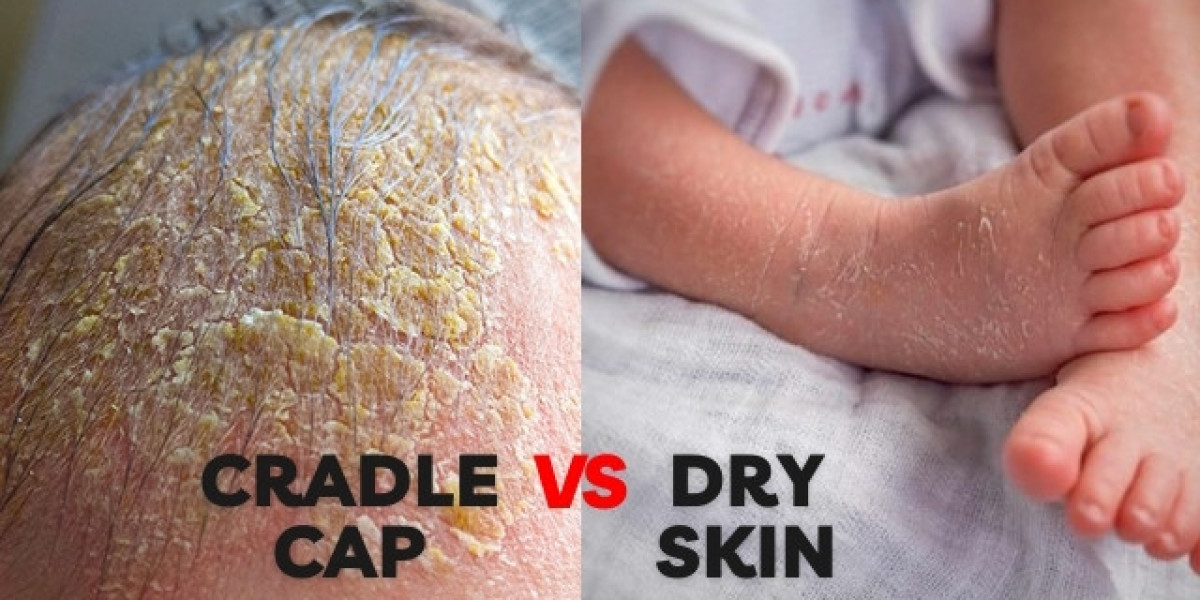As a new parent, seeing your little one develop flaky patches on their scalp can be a cause for concern. But fear not! These scaly surprises are often harmless and treatable conditions known as cradle cap vs. dry skin. While they may look similar, understanding the key differences between cradle cap vs dry skin will help you provide the best care for your precious child.
This article dives into the world of cradle cap vs dry skin, providing you with the knowledge and practical tips to navigate these common baby concerns.
Cradle Cap: A Greasy Goodbye to Flakes
Cradle cap, also known as seborrheic dermatitis, is a non-contagious condition that causes oily, yellowish patches to form on a baby's scalp. These patches may also appear on the eyebrows, behind the ears, and in skin folds like the armpits and groin area.
While the exact cause of cradle cap remains unknown, it's believed to be linked to the overproduction of oil glands stimulated by a newborn's hormones. Cradle cap typically appears within the first few weeks of life and usually resolves on its own by the age of 6 months.
Here are some key points about cradle cap to remember:
- Appearance: Oily, yellowish patches with well-defined borders. It may be accompanied by redness.
- Location: Primarily on the scalp, but it can also appear on eyebrows, behind ears, and skin folds.
- Itching: Usually doesn't cause itching, but some babies may scratch if the cradle cap is severe.
- Contagiousness: Not contagious.
Dry Skin: When Flakes Take Flight
Dry skin, a common concern for babies and adults alike, occurs when the skin loses moisture and becomes flaky, itchy, and irritated. This can be caused by various factors, including:
- Dry weather: Cold, dry winters can wreak havoc on your baby's delicate skin.
- Harsh soaps and detergents: Strong soaps can strip away natural oils, leaving the skin dry and irritated.
- Frequent bathing: While keeping your baby clean is essential, over-bathing can remove natural oils, leading to dryness.
- Underlying skin conditions: In some cases, dry skin can be a symptom of eczema or other skin conditions.
Here's a quick guide to recognizing dry skin:
- Appearance: Dry, flaky patches that may appear white or red.
- Location: It can appear anywhere on the body but is commonly seen on the face, cheeks, and legs.
- Itching: Dry skin can be quite itchy, causing your baby discomfort and potentially leading to scratching and irritation.
- Contagiousness: Not contagious.
Tips to Soothe Dry Skin:
- Moisturize regularly: Use a gentle, fragrance-free moisturizer after bathing and throughout the day, especially during dry weather.
- Lukewarm baths: Avoid hot baths, which can strip away natural oils. Opt for lukewarm baths with a gentle, fragrance-free cleanser.
- Pat dry, don't rub: After bathing, gently pat your baby's skin dry with a soft towel. Avoid rubbing, which can irritate the skin further.
- Humidifier: Using a cool-mist humidifier can add moisture to the air, which is especially helpful in dry climates.
- Consult your paediatrician: If your baby's dry skin is severe, persistent, or accompanied by other symptoms, consult your paediatrician for diagnosis and treatment recommendations.
Cradle Cap vs. Dry Skin:
While both cradle cap vs. dry skin cause flaking, some key differences can help you distinguish between the two:
- Oiliness: The cradle cap is typically oily and greasy, while dry skin feels rough and dry to the touch.
- Location: Cradle cap primarily affects the scalp and occasionally other oily areas, while dry skin can appear anywhere on the body.
- Itching: Cradle cap usually doesn't cause itching, while dry skin can be quite itchy.
- Crusting: Cradle cap scales may be thicker and more crusty than dry skin flakes.
Conclusion:
By understanding the differences between cradle cap and dry skin, you can provide the best care for your little one's delicate skin. Here's a quick recap:
- Cradle cap: Oily, yellowish patches typically on the scalp, usually resolves on its own by six months.
- Dry skin: Flaky, itchy patches that can appear anywhere on the body, often worsened by dry weather or harsh soaps.
Remember:
- Both cradle cap and dry skin are non-contagious.
- Gentle care and appropriate moisturization are key to managing both conditions.
- If your baby's condition seems severe or persistent, or you have any concerns, consult your paediatrician for diagnosis and personalized advice.
Keeping Your Baby's Skin Happy and Healthy:
Here are some additional tips to keep your baby's skin happy and healthy:
- Dress your baby in soft, breathable fabrics: Avoid rough or irritating materials like wool. Opt for cotton clothes that allow the skin to breathe.
- Sun protection: Even on cloudy days, protect your baby's delicate skin from the sun's harmful rays with sunscreen formulated for babies (SPF 30 or higher).
- Diaper rash prevention: Change diapers frequently and clean the diaper area thoroughly with warm water and a gentle cleanser to prevent diaper rash.
- Avoid harsh chemicals: Steer clear of harsh soaps, detergents, and fragranced products that can irritate your baby's skin.
- Diet: While not a direct cause of cradle cap or dry skin, some babies may experience sensitivities to certain foods that can manifest in skin issues. Talk to your paediatrician if you suspect a food allergy or intolerance might be contributing to your baby's skin problems.
The Bottom Line
Cradle cap and dry skin, while presenting with similar flaking, are two distinct conditions with different causes and management approaches. By understanding the key differences and incorporating these simple tips into your baby's skincare routine, you can ensure your little one's skin stays healthy, comfortable, and glowing.



